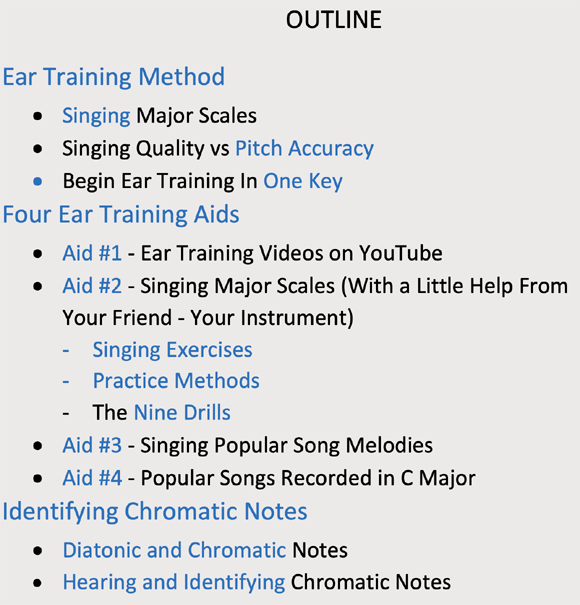
So for example, you can sing the major scale as: "one-two-three-four-five-six-seven-one" where "one" is the tonic note at both the lower and upper ends of the scale - the octave. Or you can call the upper tonic note "eight" when you sing the scale - so you would sing it as: "One-two-three-four-five-six-seven-eight" Either way is OK. "Seven" is a bit awkward to sing in a rhythmic note sequence, like in a song, since it contains two syllables. You can abbreviate it as "s'ven" or "sven" if you wish, but it's still a bit awkward. Using solfege, singing the major scale is very simple - you sing the syllables, "do-re-mi-fa-so-la-ti-do". Why is singing the scale degrees so effective in ear training? There are two reasons. The first reason:
Doing this again and again and again reinforces a connection in your brain between the name and the sound of each scale degree, so that eventually, when your ear hears a note in the scale it automatically thinks of the scale degree name - either the number or the solfege syllable. That's a powerful connection! The second reason why singing the scale degrees is so effective:
Two examples: The Christmas song, "Joy To the World" begins with the phrase, "Joy to the world, the Lord is come". The notes are a descending major scale, 1'-7-6-5-4-3-2-1 or do'-ti-la-so-fa-mi-re-do. If you've trained your ear by singing major scales, you will immediately recognize the scale, and you can play it instantly, without doing the work of hearing and identifying each individual note. The popular song, "Lean On Me", by Bill Withers begins with the phrase "Some-times in our lives, we all have pain". You will immediately recognize the phrase, 1-1-2-3-4-4-3-2-1 or do do re mi fa, fa mi re do - an ascending scale sequence followed by a descending sequence, first going four notes up the scale and then back down the same four notes. You will quickly identify each sequence and play it as a group. Examples like this abound in popular songs. Singing Quality vs Pitch Accuracy Back To Top "But", you say, . . . "This is all well and good, but I don't have a good singing voice." Ah! Never fear! You don't need to have a great singing voice. The QUALITY of your singing voice is not important here - it doesn't need to sound pretty. What IS important is that you sing the PITCH of each note accurately. You need to be able to "carry a tune", as they say. Remember, your goal is to be able to play a song melody by ear - a melody that you are hearing in your head. It will be difficult to play the melody accurately if the pitches in the melody you are hearing (and singing) are not accurate. But, don't worry if this is difficult for you now. In the ear training exercises that will be described here, you will first be playing each exercise on your instrument, while you are singing it - your instrument will help you sing the correct pitches. With practice, you will eventually be able to hear and sing the correct pitches without any assistance. Singing without any accompaniment is called singing ACAPELLA. If you need additional help with this, there are various tuning apps available for iOS and Android devices which will indicate the pitch you are singing and thus help you make the needed corrections. Also, you could enlist the help of a voice teacher. Begin Ear Training In One Key In the beginning phase of ear training you will be singing the major scale in only one Key - C major. Thus, your brain will need to focus on only seven notes - the notes in the C major scale. Sing the scale degrees in the C major scale in as many ways as you can - sing up and down the scale, changing direction midway, skipping over notes, octave jumps, random sequences, etc. Eventually you will become very familiar with the sound of each scale degree in this Key. And, if you've memorized the notes that go with the scale degrees in C major, then you'll be able to identify the notes that you hear in this Key. You will have achieved relative pitch in the Key of C major! When you can listen to a song melody in C major and quickly identify the scale degrees and the actual notes, then you'll be able to play the song by ear. Your musical self-confidence will soar! And, at this point, you will likely find that you have relative pitch in other Keys as well! Once your ear finds the "groove" in C major, you will likely find you can do it in other Keys as well. So, when listening to any song melody, in any Key, your ear will quickly 'lock on' to the seven-note major scale pattern in that Key, and you will find yourself correctly identifying the scale degrees of the notes that you hear. It's magical! Back To Top FOUR EAR TRAINING AIDSHere I will provide you with four aids to assist you in the ear training process - several singing exercises and songs that will help you develop a musical ear and acquire relative pitch in C major. Aid
#1 - Ear Training Videos on YouTube
Aid
#2 - Singing Major Scales (With a Little Help From Your Friend - Your Instrument). |
 |
It's
a useful instrument if you want to hear a particular note, but it's awkward for
playing note sequences.
THE
SINGING EXERCISES Back
To Top
The group of singing exercises is a series of nine
drills where you will sing the C major scale in several different ways,
using either the scale degree numbers or the solfege syllables - your choice.
The drills are simple exercises where you sing up and down the scale, and then
more complex drills where you change direction at various points, skip over notes,
etc. while still following a pattern (with the exception of Drill 6 where there
is no pattern). [Note: If you are using the scale degree numbers, you'll find
that some of these drills overlap with those used by Tim Collins in his YouTube
videos that I mentioned earlier.] I'll provide you with the scale degrees
to sing in each drill - both numbers and solfege syllables - along with an audio
clip of me singing the drill so you'll know how it sounds.
It's best
if you do these drills in sequence and become proficient with each drill before
you proceed to the next one.
It's important that you sing each
pitch accurately, so you will use your instrument as a pitch reference as
you sing the drills. On the piano keyboard the scale degrees in C major are all
on the white keys as shown here.
 |
PRACTICE METHODS
Back
To Top
Each note sequence - except for Drill #6 - has a
definite note pattern which you will easily discover. And in some of the drills,
beginning with Drill #5, there is a rhythmic pattern in the sequence as well.
Once you see (and feel) the pattern, you can easily memorize the scale degree
sequence. Initially you will need to use your instrument to assist you in singing
the pitches accurately. But once you begin to sing a drill accurately and it's
memorized, then you can practice the drill ACAPELLA, anywhere, anytime - while
you're walking your dog, taking a shower, sitting on a park bench, waiting in
your doctor's office (sing softly), driving your car (if you can keep your attention
on the road!), etc - all you need is a pitch pipe to occasionally check your accuracy.
To keep it challenging you can change TEMPO (speed) or DYNAMICS (loud/soft) during
a drill.
For each drill, here's a method you can use when you are
singing the drill the first time:
| 1. | Before you sing, look for the pattern in the scale degree sequence - both the pitches and the rhythmic pattern if any. Speak the scale degrees and hear the pattern in the scale degree names. |
| 2. | Play the note sequence on your instrument so you will know generally what it sounds like. |
| 3. | Play the sequence again while you sing the scale degree names. |
| 4. | Depending on how well you think you know the sequence and the pitches, sing it acapella at a slower tempo - stopping at one or more intermediate notes to check your pitch accuracy using your instrument or pitch pipe. Also, check for accuracy on the final note. Repeat until you are confident that you are singing the pitches accurately at the slower tempo. |
| 5. | Repeat step 4 several times, each time at a slightly increased tempo as long as you are singing the pitches accurately. |
| 6. | Sing the sequence acapella, checking for accuracy only on the final note. If you can sing the sequence accurately, then sing it again at various tempos. If you are unable to sing the pitches accurately, then go back and repeat steps 4 and 5. |
You can adapt these steps to your needs, as you wish
- whatever works for you. In the audio recordings, some note sequences are repeated
at different tempos.
If you are having difficulty singing the pitches
accurately you may need to continue using your instrument to play every note in
the drill as you sing through the note sequences. That's perfectly OK - you are
helping your brain make the connections when you do this. Just remember that it's
beneficial to eventually be able to sing each drill accurately, acapella,
and at various tempos.
THE
NINE DRILLS Back
To Top
Here are the nine drills,
to give you practice singing the C major scale in several different ways. For
each drill you can click on the play button to hear me singing the drill acapella.
Notes with apostrophe are in the upper octave; underlined notes are in the lower
octave.
DRILL 1. SING THE LOWER HALF OF THE MAJOR SCALE Sing the numbers:
|
| DRILL 2. SING THE ENTIRE MAJOR SCALE Sing the entire C major scale, up to the octave C' and back down to C. 1-2-3-4-5-6-7-8 8-7-6-5-4-3-2-1 Or, do-re-mi-fa-so-la-ti-do' do'-ti-la-so-fa-mi-re-do |
| DRILL 3. SING UP TO EACH SCALE DEGREE AND BACK DOWN Sing from scale degree 1 / solfege "do" up to each scale degree, then back down to 1 / "do". 1-2-1 1-2-3-2-1 1-2-3-4-3-2-1 1-2-3-4-5-4-3-2-1 1-2-3-4-5-6-5-4-3-2-1 1-2-3-4-5-6-7-6-5-4-3-2-1 1-2-3-4-5-6-7-8-7-6-5-4-3-2-1 Or, do-re-do do-re-mi-re-do do-re-mi-fa-mi-re-do do-re-mi-fa-so-fa-mi-re-do do-re-mi-fa-so-la-so-fa-mi-re-do do-re-mi-fa-so-la-ti-la-so-fa-mi-re-do do-re-mi-fa-so-la-ti- do'-ti-la-so-fa-mi-re-do |
DRILL 4. 8-7-8 |
Beginning with Drill 5, abbreviated solfege (d r m f s l t d') will be used for simplicity. If you are using solfege, you'll find this notation very handy if you are transcribing music or making notes (written notes) to yourself.
Don't do Drill 5 until you are proficient with drills 3 and 4.
| DRILL 5. REVERSING DIRECTION Sing these two scale degree sequences - each contains several direction reversals. 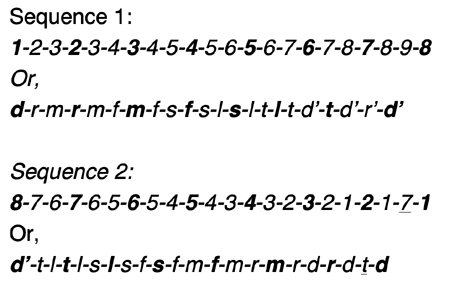 Notice that in each sequence the pattern is in groups of 3. The rhythm is 1-2-3-1-2-3-1-2-3, etc with emphasis on beat 1 in each group (shown in bold). In the first sequence, the notes on beat 1 move up the scale from scale degree 1 / do up to 8 / do'. In the second sequence, the notes on beat 1 move down the scale from 8 / do' down to 1 / do. This will help you memorize the sequences. For each sequence, speak the repeating 1-2-3 rhythm with the emphasis on beat 1, then speak the number/solfege sequence with that same rhythmic feel. Then sing the sequence while playing it on your instrument, etc. Notice how knowing the logic of the pattern and the rhythmic 'feel' make it easier to sing and memorize the patterns. Hear sequence 1 sung: Hear sequence 2 sung: |
| DRILL 6. SIGHT SINGING In this exercise you are given a sequence of notes/scale degrees that moves step-wise upward and downward in a random fashion (no skipping and no pattern). Begin with scale degree 1 / solfege do (the note C), and try to sing the sequence acapella, using your instrument only occasionally to check your pitch accuracy. This is called sight singing. Eventually, you should be able to accurately sing the entire sequence from start to finish, checking your pitch accuracy only on the first and last note. 1-2-3-4-3-2-3-2-3-4-3-4-5-4-3-4-5-6-5-6-7-8-7-6-7-8 Or, d-r-m-f-m-r-m-r-m-f-m-f-s-f-m-f-s-l-s-l-t-d'-t-l-t-d' Feel free to create new sequences to test yourself. |
DRILL 7. SKIPPING
OVER NOTES - 1  Here the pattern is in groups of 2 - the rhythm is 1-2-1-2-1-2, etc, with emphasis on beat 1. Beat 1 notes are in bold - notice how they progress up and down the scale. For each sequence, speak the repeating 1-2-1-2 rhythm with the emphasis on beat 1,then speak the number or solfege sequence with that same rhythmic feel. Then sing the sequence while playing it on your instrument, and so forth. Hear sequence 1 sung: Hear sequence 2 sung: |
DRILL 8. SKIPPING
OVER NOTES - 2  In these two sequences the pattern is in groups of 4. The rhythm is 1-2-3-4-1-2-3-4, etc with emphasis on beats 1 and 3. Again, notice how the beat 1 notes go up the scale in sequence 1 and down the scale in sequence 2 - likewise for the beat 3 notes. |
DRILL 9. SKIPPING
OVER NOTES - 3 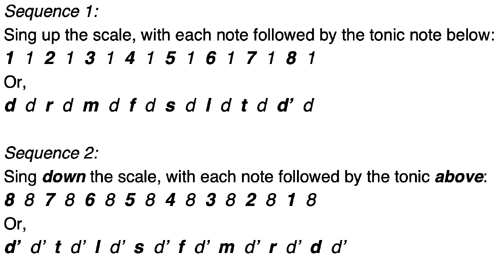 Hear sequence 1 sung: Hear sequence 2 sung: |
If you are singing the numbers and you would like to continue with even more challenging drills, then I suggest you try a YouTube video by Tim Collins as I mentioned earlier on this page. Search for Tim Collins ear training. On his YouTube channel he has a spectrum of ear training videos – from elementary to advanced. Here are two good ones you may want to begin with: “6 Easy-ish Ear Training Exercises” and “5 Ways To Use the Major Scale for EAR TRAINING”.
He uses some of the drills that I've listed here and adds several more that are more challenging - and useful. And if you prefer solfege, it’s relatively easy to convert a numbers drill into solfege. You can do it in your head if the note sequence has a pattern - and they all do.
Be kind to yourself if you are having difficulty singing the correct pitches in these drills. And don't compare your progress with someone else's or with what you thought your progress would be or should be. Take your time, be patient - and stay with it! Practice every day, if only for a few minutes.
If you memorize the pattern in a drill you can easily sing the drill while engaged in any "mindless" activity - like taking a walk, waiting for something or someone, washing dishes, lying in bed, etc. Have your pitch pipe handy to check your pitch accuracy (but don't drop it in the dish water!)
Eventually, things will come together for you!
And, as I explained earlier, if you're having difficulty matching your vocal pitches with the keyboard, called 'pitch matching' or 'singing in tune', you may want to enlist the help of a voice teacher or perhaps utilize a tuning app on your computer or smart phone.
Aid #3 - Singing Popular Song Melodies
Ear Training Aid #3 contains a second set of singing exercises. Here you are given the scale degrees of the notes in several (older) popular song melodies - to give you practice singing songs (more fun than singing scales!) Just like with the nine drills, singing these songs will help your ear make the connections between the sound of each note and its scale degree name.
And since you are likely familiar with at least some of these songs, you shouldn't need much help from your instrument to hear and sing the correct notes. However, you should sing and play each melody a few times - to make sure you are accurately singing the scale degrees that are indicated here (If you wish, you may change the scale degree names to match the notes that you prefer singing - it makes no difference).
Ways to use the songs Back To Top
Do with these songs whatever makes sense for you. You can sing and practice them like you did singing the major scale drills earlier. A good way would be to break each song into chunks. It's fairly easy to memorize the scale degree sequence in one or two lines or phrases in a familiar song melody. And it gives you a singing exercise that you can practice throughout the day as you go about your business, drilling those particular scale degrees/pitches into your brain - for example, 5-5-6-5-1'-7/so-so-la-so-do'-ti from "Happy Birthday" or 1-1'-6-5-3-5-2/do-do'-la-so-mi-so-re from "Take Me Out To the Ball Game".
Preparing your ears
Sing each melody in the Key of C major, keeping the focus on the same seven notes as before. Before you begin singing a melody, make sure your ear/brain is acclimated to the Key. Singing the tonic note and the major scale is a good way to do this. Or, you can sing a simple sequence such as 1-3-5-3-1 or 1-3-5-1'-5-3-1 or, using solfege, do-mi-so-mi-do or do-mi-so-do'-so-mi-do. These sequences, called ARPEGGIOS (skipping every other note), are extremely valuable to know and sing. Practice singing them in C major (C-E-G) until you can sing them instantly whenever you hear a C. Use your instrument to assist you when needed - always sing the correct pitches!
Some of the melodies begin with scale degree 1 or do, others with scale degree 3 or mi (song melodies usually begin with scale degree 1, 3, or 5 - do, mi, or so). If the melody does not begin on the tonic, then sing up the scale from 1 or do to find the starting note. After you've trained your ears, then in your head you will quickly hear and identify the starting note.
In some of these songs, only portions of the song melody are shown. As an exercise, you can complete the remaining verses or choruses if you wish.
Here are the song melodies and the scale degrees. Apostrophe denotes upper octave; underlines denote lower octave.
Twinkle
Twinkle Little Star: Back
To Top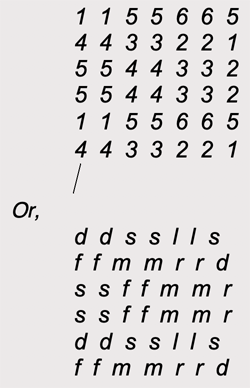 | |
Take Me Out To the Ball Game: 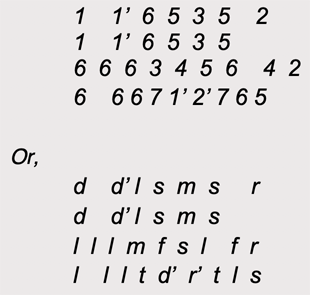 | |
King
Of the Road: 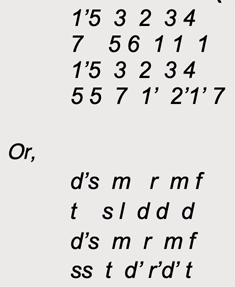 | |
Every Breath You Take: 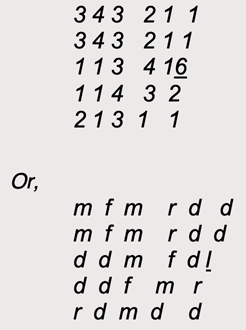 | |
My Girl: .  | |
Lullaby (Brahms): 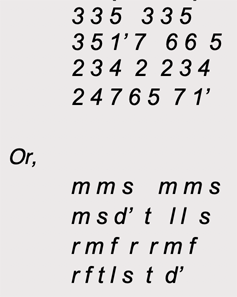 |
Aid #4 - Popular Songs Recorded in C Major
After you've spent some practice time singing drills and songs and you feel that you've begun developing a musical ear, then it's time for THE REAL TEST! --- listening to actual popular songs and identifying the scale degrees of the melody notes that you hear.
Here is a list of several popular songs that are recorded in the Key of C major.
In each of these songs, the tonic is the last note in the melody.
| • | Lean On Me (Bill Withers) Back To Top |
| • | Let It Be (Paul McCartney/Beatles) |
| • | Like a Rolling Stone (Bob Dylan) |
| • | Hallelujah (Shrek song) |
| • | Imagine (John Lennon) |
| • | When I Was Your Man (Bruno Mars) |
| • | Lost Cause (Beck) |
| • | All the Small Things (Blink-182) |
| • | Count On Me (Bruno Mars) |
| • | Something Vague (Bright Eyes) |
| • | Wake Me Up Before You Go-Go (Wham!) |
| • | Some Nights (Fun) |
| • | Sweet Talkin' Woman (Electric light Orchestra) |
When you've developed a musical ear, you'll be able to identify the scale degrees and notes in a song melody while you are playing it (playing very slowly at first!), but for now, to get you started, we'll go through the first verse of one song together - and we'll do it on paper, one phrase at a time.
EXAMPLE - "Lean On Me"
Let's look at the first song in the list, "Lean On Me". Print out the song lyrics (double spaced) - you can find them by doing an internet search on the song title followed by "lyrics". Queue up the song on YouTube.
This is a good song to begin testing your skill because the notes generally go smoothly up and down the scale - there aren't many jumps, so it's easier to follow. Keep that in mind when you are listening to it.
We know the song is in C major, so play a C and get your ear oriented to the Key by singing the major scale or 1-3-5-3-1/do-mi-so-mi-do or some such, as we discussed earlier.
Now begin playing the song. If you like, you can play it all the way through to make sure you are familiar with it. Then begin singing the melody to yourself and see if you can hear and identify the scale degree of the first note. [Stop reading here and do it.]
It's pretty clear that the starting note is the tonic, C.
The first verse is: Back To Top
| Some-time
in our lives, We all have pain we all have sor-row But - if we are wise, We know that there's Al-ways to-mor-row |
Now sing the major scale again, and see if you can identify the scale degrees of the other notes in the first line of the song.
[Stop reading and do it.]
Again, it should be clear that the first two notes are the tonic, C, and then the notes go up the scale - 1 2 3 4 or do re mi fa . Write each scale degree above the appropriate word in the lyric.
This is a good example of a song containing phrases which are portions of the major scale. If you quickly recognize that the melody here goes up the scale to scale degree 4/fa then you can instantly play the sequence from memory without needing to think about each note separately - very important if you are playing the song by ear in real time!
Now see if you can identify the scale degrees of the notes in the second line of the song. [Stop reading and do it.]
You should be able to recognize that the melody in the next line comes back down the scale to the tonic - 4 3 2 1/fa mi re do.
If you are correctly hearing the scale degrees, then continue on with this song. Sing the major scale again, and then listen to the first verse again, and see if you can confidently identify the scale degrees of the other notes In the verse. Write the scale degrees above each word - either the numbers or abbreviated solfege. The only place in this verse where the melody skips over notes is on the second syllable of "to-mor-row".
What scale degree is the second syllable of to-mor-row?
[Stop reading here and answer.]
It's scale degree 7/solfege ti. If you got the right answer, then give yourself a pat on the back - you're making progress!
When you are finished, your worksheet should look like this:
 Back
To Top
Back
To Top |
Two very important points to remember here:
| ▷ | This exercise is just an exercise - to help you get started hearing and identifying scale degrees. It's NOT the real world where you need to identify the scale degrees "on the fly". |
| ▷ | It's very important that you are confidently hearing and identifying the scale degrees when listening to this melody (and ANY melody). No guessing! Don't fall into the "trial & error trap". Trial and error is a waste of time! - you won't be training your ears at all! Don't continue on with a song if you are guessing or if you don't feel you are hearing the correct scale degrees. |
If you're having difficulty, go back and sing through
some of the exercises and practice songs that you did earlier. Then later you
can come back and test yourself again using the songs in this list.
Choose a different song or a different line in a song each time you test, because
remember, playing by ear means playing music you've never played before.
And also remember that this process takes time. You will improve in increments
- it likely will not all come to you at once (although it might). Celebrate each
little victory, however small. One step at a time. You will improve! You may find
that one day you discover that you can identify and feel the distinctive
sound of scale degree 3 / solfege mi in songs (I think
that was the first scale degree I learned to identify). Yay! Fantastic! After
that, new notes will come more easily.
And
remember . . .
The secret to acquiring relative pitch
is . . . |
Practice
ear training every day. Sing the major scale until it becomes a part of you. Try
to identify the scale degrees in song melodies that you are listening to. Eventually,
it will come to you.
And you'll be amazed at the feeling of power you'll
have when you are listening to a song and you begin hearing and accurately identifying
scale degrees - you'll find yourself picking out melodies on your instrument.
You are learning a new skill that sets you apart from many musicians!
So, . . . . Hang in there!
Back To Top
IDENTIFYING CHROMATIC NOTES
| • | Diatonic and Chromatic Notes |
| • | Hearing and Identifying Chromatic Notes. |
Recall earlier I said that the notes in every song melody generally lie within the seven-note pattern of the major scale. I said "generally" because there are some song melodies that contain one or more notes that are NOT in the major scale.
If you have relative pitch, you will recognize (but probably not identify) these notes because they aren't notes your ear is trained to hear - but you need to be able to identify them so you can play them on your instrument.
Diatonic and Chromatic Notes Back To Top
In any Key, the notes in the major scale are called DIATONIC notes. The other notes, notes not in the major scale, are called CHROMATIC notes. In most popular song melodies, every note is diatonic. And in melodies that contain chromatic notes, those notes occur infrequently, usually less than 5% of the note occurrences. Thus, you will seldom encounter chromatic notes in song melodies. But, they do occur.
Here are a few songs that contain chromatic notes. Each song title is followed by the phrase(s) containing the chromatic notes which are shown here in upper case.
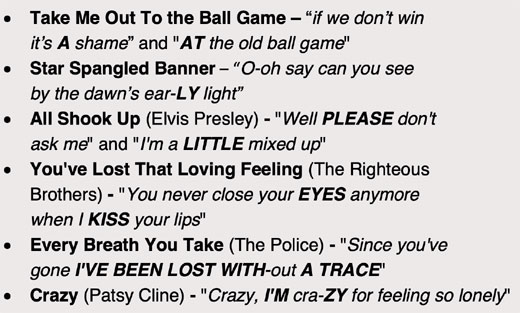
In every major Key there are seven diatonic notes and five chromatic notes. Each chromatic note lies midway between two neighboring diatonic notes, one half-step away from each - as shown in the scale degree sequences shown below (in numbers and in solfege). Each "Ch" represents the location of a chromatic note.

In the Key of C major, the chromatic notes, shown in bold below, are the five notes with accidentals - the black keys on a piano keyboard.
In other Keys, the chromatic notes are a mixture - some chromatic notes with accidentals and some without.
Hearing and Identifying Chromatic Notes
What's the best way to identify a chromatic note that you encounter in a song melody that's running in your head?
There are several methods you can use, but I recommend the Nearest Diatonic Neighbor (NDN) method. The NDN method is accurate, useful, and can be easily learned.
Nearest Diatonic Neighbor (NDN) Method Back To Top
As was illustrated earlier, each chromatic note is flanked by two diatonic notes - one half-step above and one half-step below the chromatic note. So, when you encounter a chromatic note in a song melody, sing that note and then slide up or down one half-step. You will come to a new note that is diatonic - one that you should be able to quickly recognize. Once you've identified that diatonic note, it's a simple matter to identify the chromatic note - it's either one-half step below or one half-step above the diatonic note.
EXAMPLE: Suppose you are listening to a song melody in the Key of C major, and you encounter a chromatic note. You sing that note, and then you slide up one half-step, at which point you recognize the diatonic scale degree 6 or solfege la - the note A. Now you know the chromatic note is one half-step below A, or A♭ . Voila! You could also have slid down one half-step to scale degree 5 or solfege so - the note G. The chromatic note is then one half-step above G, or G♯ which is the same as A♭ . (Voila again!)
These steps all happen very quickly once you have trained your ears to hear and identify the diatonic notes.
You will need to practice a bit using this method before it feels natural to you. You can practice with the six songs that were listed earlier - the chromatic notes are on the words and syllables shown in upper case:
The NDN method works well when there is only one chromatic note in the song - or one chromatic note in that portion of a song. Even though the chromatic note is not in the major scale, your ear is able to remain "locked on" to the diatonic notes as you move through the song. However, it gets tricky when there are two or more chromatic notes nearby in a song - like in the song "Crazy" (song #5 in the list). Notice that the two chromatic notes - on the syllables I'M and ZY - are separated with only one note in between. The second note, ZY, is particularly difficult to identify. Your ear can become confused in this situation and can easily lose track of the tonic note, and it may be several notes later before it locks on again. In this situation it's best if you use the trial and error method to identify the chromatic note in question.
Over time you'll get better at this - eventually you may be able to immediately recognize the distinctive sound of each chromatic note and identify where it lies in the scale. Fortunately, you won't encounter chromatic notes very often, so it's not a major issue in playing song melodies by ear.

